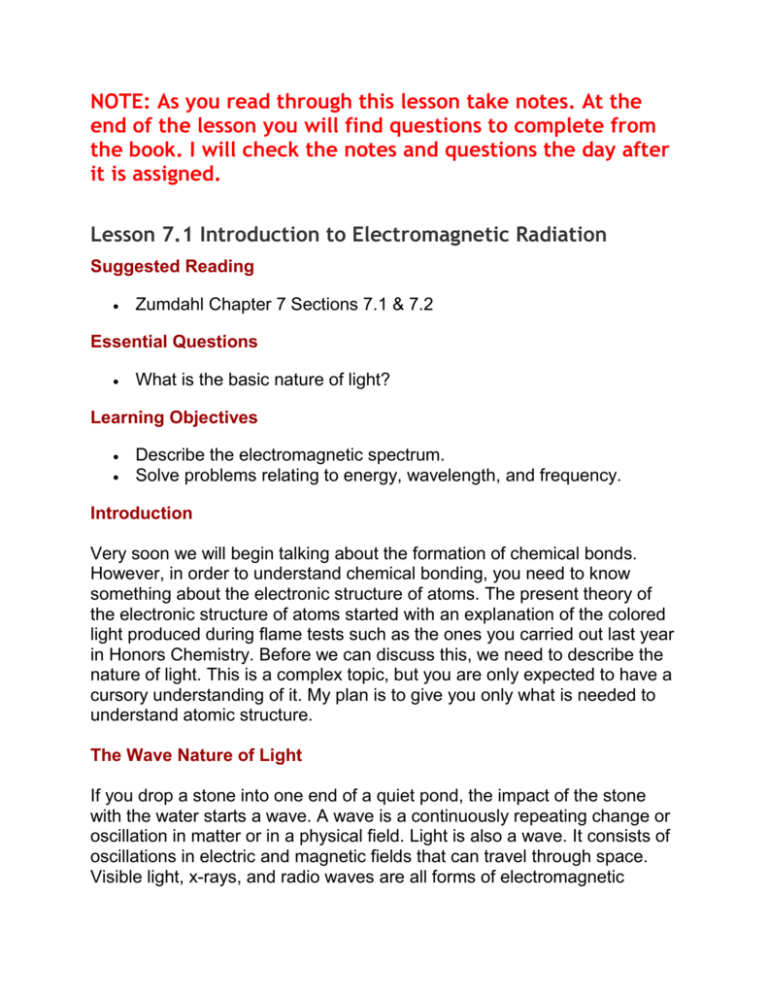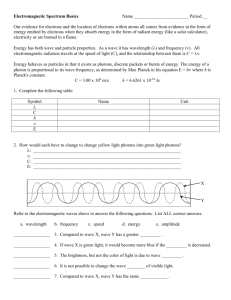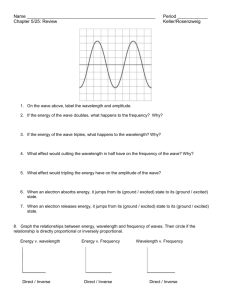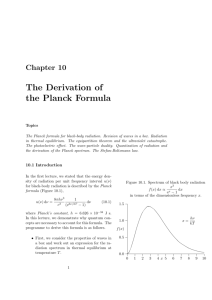Lesson 7.1 Electromagnetic Radiation
advertisement

NOTE: As you read through this lesson take notes. At the end of the lesson you will find questions to complete from the book. I will check the notes and questions the day after it is assigned. Lesson 7.1 Introduction to Electromagnetic Radiation Suggested Reading Zumdahl Chapter 7 Sections 7.1 & 7.2 Essential Questions What is the basic nature of light? Learning Objectives Describe the electromagnetic spectrum. Solve problems relating to energy, wavelength, and frequency. Introduction Very soon we will begin talking about the formation of chemical bonds. However, in order to understand chemical bonding, you need to know something about the electronic structure of atoms. The present theory of the electronic structure of atoms started with an explanation of the colored light produced during flame tests such as the ones you carried out last year in Honors Chemistry. Before we can discuss this, we need to describe the nature of light. This is a complex topic, but you are only expected to have a cursory understanding of it. My plan is to give you only what is needed to understand atomic structure. The Wave Nature of Light If you drop a stone into one end of a quiet pond, the impact of the stone with the water starts a wave. A wave is a continuously repeating change or oscillation in matter or in a physical field. Light is also a wave. It consists of oscillations in electric and magnetic fields that can travel through space. Visible light, x-rays, and radio waves are all forms of electromagnetic radiation (EMR). Wavelength and Frequency Waves are characterized by their wavelengths and frequencies. The wavelength, denoted by the Greek letter λ (lambda), is the distance between any two adjacent identical points of the wave. Thus, the wavelength is the distance between two adjacent peaks or troughs. The frequency of a wave is the number of wavelengths of that wave that pass a fixed point per unit of time (usually 1 second). Frequency is denoted by the greek letter ν (nu, pronounced "new").The unit of frequency is /s or s1 , which is also called the hertz (Hz). The wavelength and frequency are related to each other. For two waves traveling with a given speed, wavelength and frequency are inversely related: the greater the wavelength, the lower the frequency and vice versa. The product νλ, is the total length of the wave that has passed the fixed point in 1 second. This length of wave per second is the speed of the wave. For light of speed c c = νλ This is commonly referred to as "light speed" or the speed of light, which, in a vacuum, is equal to 3.00x108 m/s. The speed in air is only slightly less, so this value is treated as a constant.For calculations involving the speed of light, we assume the light is traveling in a vacuum. This is a very simple equation, so the problems relating to this equation are fairly easy. Watch the tutorial to see some examples: Watch this YouTube Video https://www.youtube.com/watch?v=goJl54Y1hio The Electromagnetic Spectrum The range of frequencies or wavelengths of electromagnetic radiation is called the electromagnetic spectrum. Note that visible light extends from the violet end of the spectrum, which has a wavelength of about 400 nm, to the red end, with a wavelength of less then 800 nm. Beyond these extremes, electromagnetic radiation is not visible to the human eye. Infrared radiation (IR) has wavelengths greater than 800 nm (greater then the wavelength of red light), and ultraviolet radiation has wavelengths less than 400 nm (less than the wavelength of violet light). The following mnemonic device is often used to help remember the visible light spectrum: Quantum Effects and Photons In the early 1800s scientists debated about the nature of light. Isaac Newton suggested that light consisted of a beam of particles while others thought it had wave properties. By the early part of the twentieth century, the wave theory of light was well entrenched. But in 1905, German physicist Albert Einstein (emigrated to the U.S. in 1933) discovered that he could explain a phenomena known as the photoelectric effect by postulating tht light had both wave and particle properties. Einstein based his work on the work of another German physicist named Max Planck. Planck's Quantization of Energy Planck carried out experiments with solids and discovered that the atoms of solids oscillate, or vibrate, with a definite frequency, ν, depending on the solid. This led him to conclude that the vibrational energies of the atoms were quantized, which means they were limited to certain values. The equation Planck used to calculate this energy was E = nhν, where n = 1,2,3 ... The symbol h is a constant now called Planck's constant, which is equal to 6.63 x 10 -34 J ∙ s. The numbers symbolized by n are called quantum numbers, where the value of n must be 1 or 2 or some other whole number. This probably sounds like a bunch of gobly goo, but Planck's work provides a basis for the quantum model of the atom; our present theory of atomic structure. Therefore, you must be familiar with Planck and his work. Photoelectric Effect Einstein used Planck's work in his explanation of the structure of light. Einstein suggested that lights consists of quanta (now called photons), or particles of electromagnetic energy, with energy E proportional to the observed frequency of light: E = hν The photoelectric effect is the ejection of electron from the surface of a metal when light shines on it. Electrons are only ejected when the frequency of light exceeds a certain threshold value characteristic of the particular metal. To explain this, Einstein assumed that the photons in the light must have a least enough energy to remove the electron from the attractive forces of the metal. Thus, Einstein showed that the photoelectric effect depended on both the frequency of light (waves) and the photons within the light (particles), which means that light has properties of both particles and waves. This is called the wave-particle duality of light, which is displayed in the equation E = hν. E is the energy of a light particle or photon, and v is the frequency of the associated wave. Neither the wave nor the particle view alone is a complete description of light. Example: Calculating the Energy of a Photon (This is an important problem type) The red spectral line of lithium occurs at 671 nm (6.71 x 10-7 m). Calculate the energy of one photon of this light. Solution: The frequency of light can be found using c = νλ by rearranging to give ν = c/λ = (3.00 x 108 m/s) ÷ (6.71 x 10-7 m) = 4.47 x 1014/s. The energy of one photon is E = hv = (6.63 x 10 -34 J ∙ s) x (4.47 x 1014/s) = 2.96 x 10-19 J Good dimensional analysis skill will come in handy here. Analyze the units to see your way to the solution!!! **This lesson is courtesy of Kimberly Richardson Homework problems: Book questions pg. 321 questions 31, 33, 35,37










